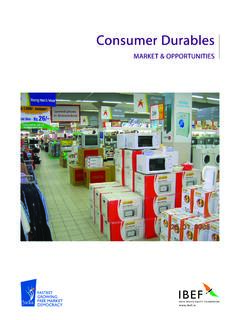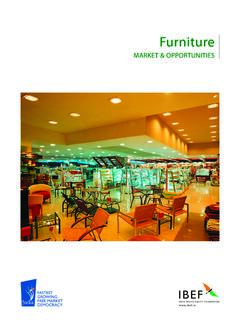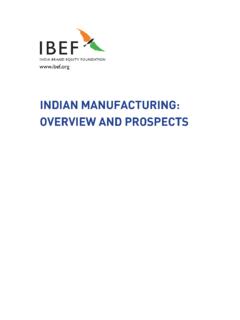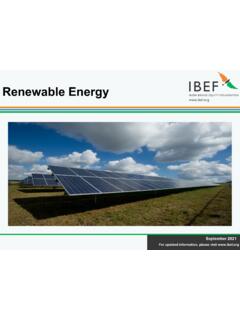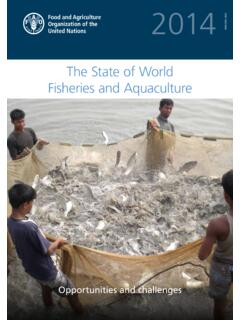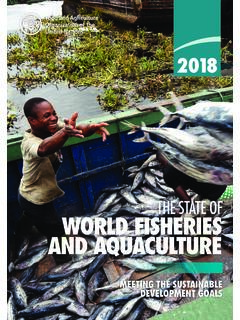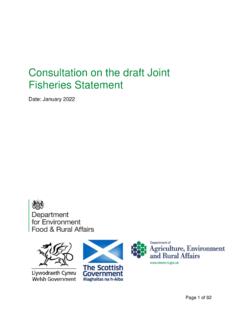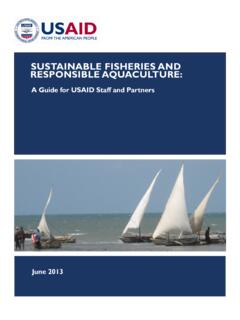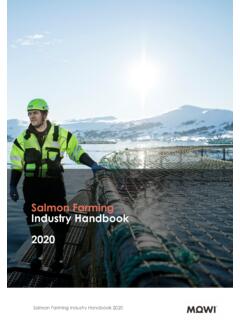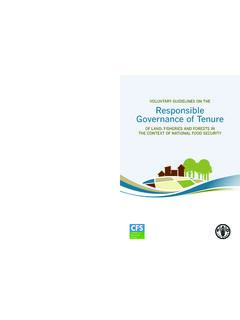Transcription of OPPORTUNITIES IN THE INDIAN AQUACULTURE INDUSTRY
1 AQUACULTURE IN INDIAA quaculture is one of the fastest-growing sectors in the world . India, with its vast coastal area, offers immense OPPORTUNITIES for sheries in both marine and inland waters. The country has the second-largest share in the global AQUACULTURE market , mainly due to its million hectares of ponds and tanks, a coastline of 7,500 kms and brackish water area of million, which offers a ground for sh farming. In India, the sheries sector is a means of livelihood for ~28 million people in the country. The country s AQUACULTURE sector is mainly fragmented into inland and marine sheries. A brief description of the sectors in sheries is listed in the below INTHE INDIAN AQUACULTURE INDUSTRY12 The Food and Agriculture Organisation (FAO) 2020 report revealed that Asia has the largest share in the global sh production at 89%, since the last 20 years.
2 In 2018, the global capture sh production reached the highest-ever level and recorded million tonnes; this was driven by marine capture and inland shing. The top seven key producers were China, Indonesia, Peru, India, Russia, the US and Vietnam, accounting for ~50% of the total global capture 's Fish Production (million metric tonnes)India accounts for of the global production. Fish production in the country reached an all-time high of million metric tonnes between 2019 and 2020. The sheries sector contributes to the gross value added (GVA) and to the agricultural 's Fish Production (million metric tonnes)Source: Department of Animal Husbandry and Dairying and Department of Fisheries, Economic Survey 2020-213 India's Share of Fish, Crustaceans and Molluscs & Preparations in world ExportThe INDIAN sheries sector has witnessed a major transformation from traditional marine sheries to a controlled inland shery setup, which is now a key contributor to the overall sh production in the REVOLUTIONBlue Revolution was launched (between 1985 and 1990) in the 7th ve-year plan, with an objective to boost sheries and extend bene ts to the shermen community.
3 The Ministry of Fisheries, Animal Husbandry and Dairying manages the objectives of Blue Revolution by focusing on ways to enhance productivity of AQUACULTURE and sheries from both the inland and marine sources. The ministry also encourages economically backward sections such as scheduled castes, scheduled tribes and women to take up job OPPORTUNITIES in this included under the Blue Revolution scheme are as follows: National Fisheries Development Board (NFDB) and its activities Strengthening database and geographical information system of the sheries sector Developing inland sheries and AQUACULTURE Operating the National Scheme of Welfare of Fishermen Developing marine sheries, infrastructure and post-harvest operations Monitoring, control and surveillance (MCS)
4 And other need-based interventions Institutional arrangement for the sheries sectorObjectives of Blue Revolution Leveraging India s sh production potential on both island and the marine sector Upgrading shery mechanism through new technologies and automation Boosting incomes of shermen by enhancing productivity and improving post-harvest infrastructure such as marketing, logistics, e-commerce, technology and innovation Ensuring active participation in development programmes and schemes from the shing ministry Accelerating export earnings with a key focus on bene ts covering the institutional mechanisms Enhancing food and nutritional security of the country4 Developments through Blue RevolutionThe Blue Revolution initiative joined forces with Fish Farmers Development Agency (FFDA) to develop the AQUACULTURE and sheries sector by introducing innovations in rearing, marketing, exporting and sh breeding.
5 As of 2019, India achieved a record annual growth of , higher than the global average of , in the production of sh and sh products. The country has become the world s second-largest producer of shes and sh products, with exports worth >Rs. 47,000 crore (US$ billion). Fishery has taken a signi cant share in India s exports over the last ve years with a growth rate of 6-10%. The sector also contributes 1% to the overall GDP and 5% to India s agricultural GDP. Currently, the US is the largest importer of INDIAN seafood products, with a share of , followed by South East Asian countries at and the European Union countries at INITIATIVESP radhan Mantri Matsya Sampada Yojana (PMMSY)In May 2020, the government launched Pradhan Mantri Matsya Sampada Yojana (PMMSY), a new agship scheme, to fully tap the potential of India s sheries sector.
6 The scheme was launched with an estimated investment of Rs. 20,050 crores (US$ billion) for ve years from FY 2020-21 to FY 2024-25. This investment is the highest-ever in India s sheries sector. The PMMSY will extend welfare programmes and social security schemes to all shermen. The scheme will also facilitate the Department of Fisheries to smoothen the value chain, including infrastructure modernisation, traceability, production, post-harvest management and quality control. This ambitious scheme aims to: Increase sh production to 220 lakh metric tonnes by 2024-25. Double export earnings to Rs. 1,00,000 crores (US$ billion). Generate ~55 lakhs employment OPPORTUNITIES in the sheries sector. Increase AQUACULTURE productivity to 5 tonnes per hectare (up from national average of 3 tonnes per hectare).
7 Boost domestic sh consumption and attract investments in the sheries PMMSY scheme introduced insurance coverage for shing vessels; this was rst-of-its-kind move in the sector. The scheme gathered attention from state governments, and by January 2021, project proposals worth Rs. 6, crore (US$ million) were received and of these, projects worth Rs. crore (US$ million) have already been of FisheriesThe Department of Fisheries came into existence in February 2019 and falls under the Ministry of Fisheries, Animal Husbandry and Dairying. The department is responsible for 5formulating policies and schemes to develop inland, marine and coastal sheries in the country. It also oversees shery institutes, namely Fishery Survey of India, Mumbai; Central Institute of Fisheries Nautical and Engineering Training (CIFNET), Kerala; Central Institute of Coastal Engineering For Fishery (CICEF), Bangalore; National Institute of Fisheries Post Harvest Technology and Training (NIFPHATT), Kochi; National Fisheries Development Board (NFDB), Hyderabad; and Coastal AQUACULTURE Authority, and AQUACULTURE Infrastructure Development Fund (FIDF)The INDIAN government established a dedicated Fisheries and AQUACULTURE Infrastructure Development Fund (FIDF) with an investment of Rs.
8 7,522 crore (US$ billion) in October 2018. FIDF pool is a contribution of National Bank for Agriculture and Rural Development (NABARD), National Cooperatives Development Corporation (NCDC) and scheduled banks. By the end of 2020, projects worth Rs. 3,467 crore (US$ million) were approved for 13 states. As of mid-January 2021, a total of 44,673 Kisan credit cards were issued to shermen and an additional lakh applications from shermen were in process with banks. Under the FIDF scheme, a person can avail loan over a period of ve years, with maximum repayment period of up to 12 years. The fund also caters to various needs of the AQUACULTURE sector, including constructing ponds, installing cages in reservoirs, sh processing units, and FIDF aims to: Improve infrastructure for the sheries sector by developing shing harbours, sh landing centres, sh seed farms, sh feed plants, etc.
9 Achieve sustainable growth of 8-9% and scale up to 20 million metric tonnes in sh production by 2022-23. Create lakh employment OPPORTUNITIES . Attract private investments in the sector. Adopt innovative technologies for shing and the aftermarket processes. Strengthen cold chain infrastructure facilities such as ice plants, cold storage, sh logistics, sh processing units and sh July 2020, the government partnered with the Department of Fisheries and the NABARD for sanctioning a FIDF loan of Rs. 450 crore (US$ million) for construction of three shing harbours Uppada in East Godavari district, Machilipatnam Phase-II and Nizampatnam Phase-II. The total project cost is ~Rs. 1,016 crore (US$ million). Budget 2020-21In Union Budget 2021-22, the government increased allocation to the Department of Fisheries from Rs.
10 825 crore (US$ million) in the previous year to Rs. 1, crore (US$ million), which is the highest-ever budgetary support received by the department. In addition, Rs. 1000 crore (US$ million) was allocated for the Pradhan Mantri Matsya Sampada Yojana (PMMSY) , Finance Minister Nirmala Sitharaman proposed substantial investments towards developing modern shing harbours and sh landing centres. Kochi, Chennai, Visakhapatnam, Paradip and Petuaghat shing harbours will be the rst ve benefactors of the new INITIATIVES TO BOOST AQUACULTUREGOAOn February 7, 2021, Union Fisheries Minister Giriraj Singh announced an investment of Rs. 400 crore (US$ million) in Goa. These funds will be used to construct 30 sh landing jetties linked to the main roads, where shermen can anchor their boats near their villages.




